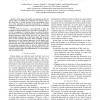Free Online Productivity Tools
i2Speak
i2Symbol
i2OCR
iTex2Img
iWeb2Print
iWeb2Shot
i2Type
iPdf2Split
iPdf2Merge
i2Bopomofo
i2Arabic
i2Style
i2Image
i2PDF
iLatex2Rtf
Sci2ools
93
Voted
ICRA
2010
IEEE
2010
IEEE
Inferring the semantics of direction signs in public places
Abstract— Most large-scale public environments provide direction signs to facilitate the orientation for humans and to find their way to a goal location in the environment. Thus, for a robot operating in the same environment, it would be beneficial to interpret such signs correctly for a safe and efficient navigation. In this work, we propose a novel approach to infer the meaning of direction signs and to use that for navigation, i.e., to find a mapping of a detected sign to a motion direction. Our method uses a hierarchical extension of the Implicit Shape Model framework called HISM that does not require any hand-labeled training data to detect the signs. On the lower level of this two-stage hierarchy, ISM is applied to image descriptors as in the standard approach. On the higher level, ISM operates on subparts of signs called tokens, using weights learned from data. The interpretation of the signs is inferred by associating navigation data to direction instructions. We conducte...
Related Content
| Added | 26 Jan 2011 |
| Updated | 26 Jan 2011 |
| Type | Journal |
| Year | 2010 |
| Where | ICRA |
| Authors | Jérôme Maye, Luciano Spinello, Rudolph Triebel, Roland Siegwart |
Comments (0)

